Chapter: Digital Logic Circuits : Asynchronous Sequential Circuits and Programmable Logic Devices
Using a One Hot State Assignment
USING A ONE HOT STATE ASSIGNMENT
When designing with PGAS4, we should
keep in mind that each logic cell contains two flip flops. This means that it
may not be important to minimize the number of flip flops used in the design.
Instead, we should try to reduce the number of logic cells used and try to
reduce the interconnections between cells. In order to design faster logic, we
should try to reduce the number of cells required to realize each equation.
Using one hot state assigning will often help to accomplish this.
The one hot assignment uses one flip
flop for each state, so a state machine with N states requires N flip flop.
Exactly one flip flop is set to l in each state. For example a system with four
(To T1, T2 and T3) could use four flip flop (O0,
Q1, Q2 and Q3) with the following state
assignment.

The other 12 combinations are not
used.
We can write next state and output
equations by inspection of the graph or by tracking link parts on an SM chart
consider the partial state graph . The next state equation for flip flop Q3
could be written as.

However since Q=1 implies Q1=Q2=Q3=0
the Q1=Q2=Q3 term is redundant and can be eliminated, similarly, all the primed
state variables can be eliminated from the other terms, so the next state
equation reduces to.

Note that each contains exactly one
state variable. similarly, each term in each output equation contains exactly
one state variable.

When a one hot assignment is used,
the next state equation for each flip flop will contain one term for each are
leading into the corresponding state (or for each link path leading into the
state). In general, each term in every next state equation and in every output
equation will contain exactly one state variable. The one hot state assignment
for asynchronous networks is similar to that described above, but a “holding
term” is required for each next state equation.
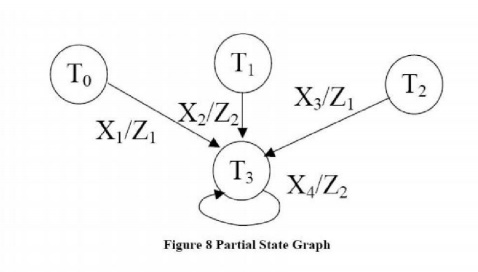
When a one hot assignment is used,
resetting the system requires that one flip flop be set to 1 instead of
resetting all flip flops to 0. If the flip flops used do not have a preset
input (as in the case for the xilnx 3000 series), then we can modify the one
hot assignment by replacing Q0 and Q0’ throughout. For
the assignment, the modification is

And the modified equations are:

Another way to solve the reset
problem without modifying the one hot assignment is to add an extra term to the
equation for the flip flop, which should be 1 in the starting state. As an
example, we use the one hot assignment given in (6-6) for the main dice game
control. The next state equation for QO is

If the system is reset to state 0000
after power-up, we can add the term Q0’Q1’Q2’Q3’
to the equation for Q0. Then, after the first clock the state will
change from 0000 and 1000 (T0), Which is the correct starting state.
In general, both an assignment with
a minimum number of state variables and a one hot assignment should be tried to
see which one leads to a design with the smallest number of logic cells.
Alternatively, if speed of operation is important, the design that leads to the
fastest logic should be chosen. When a one hot assignment is used, more next
state equations are required, but in general both the next state and output
equation will contain fewer variables. An equation with fewer variable
generally requires fewer logic cells to realize. Equations with five or fewer
variables require a single cell. As seen in figure, an equation with six
variables require cascading two cells, an equation with seven variables may
require cascading three cells etc. The more cells cascaded, the longer the
propagation delay, and the slower the operation.
STAT
ASSIGNMENT RULES: A set of heuristic rules that attempts to
reduce the cost of the combinational logic in a finite state machine.
ONE
HOT STATE ASSIGNMENT: State
assignment uses one flip flop for each state, so a state machine with N states
requires N flip flops.
1. Reduce
the following state table to the minimum number of states using successive
partitioning method.
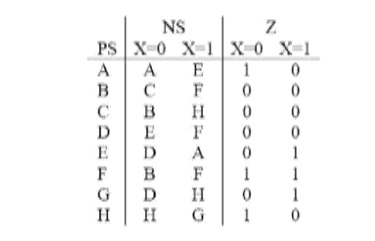
2. Reduce
the following state table to the minimum number of states using implication
chart method.
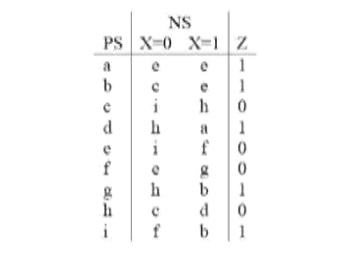
3. Use
the heuristic rule on page 4 to make compact state assignment. Assign state A
to “000”.
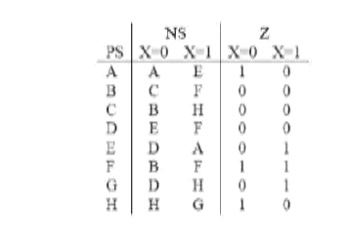
4. Implement
the following state using D flip flop and gates. Use a one hot assignment and
write down the logic equations by inspecting the state table. Let S0=001,
S1=010, and S2=1000.
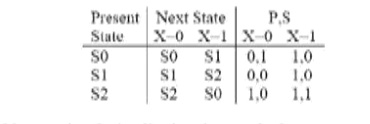
5. Repeat
problem 1 using the implication chart.
6. Repeat
problem 2 using the successive partitioning method.
7. Implement
the state of problem 3 using one hot state assignment. Assume A=00000001,
B=00000010, through H=10000000.
Related Topics